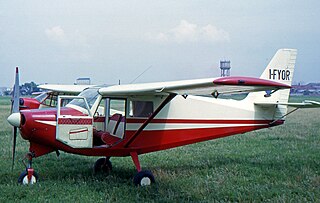Related Research Articles

Miles was the name used between 1943 and 1947 to market the aircraft of British engineer Frederick George Miles, who, with his wife – aviator and draughtswoman Maxine "Blossom" Miles – and his brother George Herbert Miles, designed numerous light civil and military aircraft and a range of curious prototypes.

The PA-25 Pawnee is an agricultural aircraft produced by Piper Aircraft between 1959 and 1981. It remains a widely used aircraft in agricultural spraying and is also used as a tow plane, or tug, for launching gliders or for towing banners. In 1988, the design rights and support responsibility were sold to Latino Americana de Aviación of Argentina.

The Piper PA-18 Super Cub is a two-seat, single-engine monoplane. Introduced in 1949 by Piper Aircraft, it was developed from the PA-11 Cub Special, and traces its lineage back through the J-3 Cub to the Taylor E-2 Cub of the 1930s. In close to 40 years of production, over 10,000 were built. Super Cubs are commonly found in roles such as bush flying, banner towing and glider towing.

The Citabria is a light single-engine, two-seat, fixed conventional gear airplane which entered production in the United States in 1964. Designed for flight training, utility and personal use, it is capable of sustaining aerobatic stresses from +5g to -2g. Its name, "airbatic" backwards, reflects this.

The Miles M.57 Aerovan was a British twin-engined short-range low-cost transport aircraft designed and produced by Miles Aircraft. It was primarily used for freight and passenger services.

The Turbomeca Astazou is a highly successful series of turboprop and turboshaft engines, first run in 1957. The original version weighed 110 kg (243 lb) and developed 240 kW (320 shp) at 40,000 rpm. It was admitted for aviation service on May 29, 1961, after a 150-hour test run. The main developing engineer was G. Sporer. It was named after two summits of the Pyrenees.

The PZL-105 Flaming (flamingo) is a Polish short-takeoff-and-landing (STOL) utility aircraft designed by PZL "Warszawa-Okęcie". It remained a prototype.

The Nesmith Cougar is a light aircraft that was developed in the United States in the 1950s and marketed for homebuilding.

The Hurel-Dubois HD.10 was a French research aircraft first flown in 1948 to investigate Maurice Hurel's ideas about high aspect ratio wings. It was a single-seat monoplane with a retractable tricycle undercarriage and twin tails, featuring a very high aspect-ratio wing of 32.5:1. This was mounted above the aircraft's enclosed cockpit and braced with struts. Construction was of metal throughout. Between 1948 and 1954, this aircraft accumulated some 218 hours and 27 minutes of flight time and is now preserved in the Musée de l'Air et de l'Espace in Paris.

The Hurel-Dubois HD.31, HD.32, and HD.34 were a family of civil aircraft produced in France in the 1950s, based on Maurice Hurel's high-aspect ratio wing designs.

The Partenavia P.57 Fachiro is an Italian, four-seat, high-wing, touring monoplane, fitted with a fixed tricycle undercarriage.

The Scintex ML 250 Rubis was a French civil utility aircraft of the 1960s.

The Miles M.68 was a 1947 attempt to produce a containerised freighter aircraft by the modification of the Miles Aerovan. The container or air-trailer was part of the fuselage but could be dismounted and towed on the road.

The I.S.T. XL-15 Tagak was a single-engine, twin-boom, high-wing monoplane designed after the I.S.T. XL-14 Maya and built in the Philippines in the mid-1950s. The result of a collaboration between a Government research institute and the Philippine Air Force, it was designed as a utility, liaison or ambulance aircraft and as a test bed for the use of local materials in aviation.

The Short SC.7 Skyvan is a British 19-seat twin-turboprop aircraft manufactured by Short Brothers of Belfast, Northern Ireland. It is used mainly for short-haul freight and skydiving.

The Stolp-Adams SA-100 Starduster is an American single-seat sport biplane designed to be built from plans supplied by Aircraft Spruce & Specialty Co. Though the first flight was in 1957, Stardusters continue to be built and flown.

The Turbay T-3A was an Argentine twin-engined seven-seater light transport of the 1960s. A single example was built, but no production followed.
The MMPL Kanpur was an Indian light four-seat aircraft, designed for service and agricultural work in the early 1960s. It is a rare example of an aircraft designed and built by a national air force for its own use.

The Les Mureaux 3 C.2 and Les Mureaux 4 C.2 were French two seat, parasol winged fighters, flown in 1927-8, which differed only in their engines. They were developed into near identical army co-operation types, the ANF Les Mureaux 130 A.2 and ANF Les Mureaux 131 A.2, in 1929–31.
The Renard R.33 was a Belgian training aircraft with aerobatic capability. Two were flown in 1934 but no more were produced.
References
- 1 2 LAMBERT, C. M. (6 June 1958). "Foretaste of the Caravan HDM.105 HANDLING AND HDM.106 PROSPECTS". Flight and Aircraft Engineer. 73 (2576): 776–777.
- 1 2 3 4 5 6 Brown, Don L. (1970). Miles Aircraft since 1925 (1st ed.). London: Putnam & Company Ltd. pp. 354–356. ISBN 0-370-00127-3.
- ↑ Brown, Don L. (1970). Miles Aircraft since 1925 (1st ed.). London: Putnam & Company Ltd. pp. 356–357. ISBN 0-370-00127-3.
- 1 2 Bridgman, Leonard, ed. (1957). Jane's All the World's Aircraft 1958-59. London: Jane's All the World's Aircraft Publishing Co. Ltd. pp. 95–96.